Analyzing Discrimination in Sentencing within the US: An Overview
VerifiedAdded on 2022/09/10
|6
|1666
|19
Essay
AI Summary
This essay delves into the issue of discrimination in sentencing within the United States, highlighting the disproportionate impact on racial and ethnic minorities. It argues that institutional racism within the US criminal justice system leads to specific groups, particularly blacks, Latinos, and indigenous peoples, being incarcerated at higher rates, often for non-violent offenses. The essay points to factors such as media bias, racial profiling by law enforcement, and discriminatory drug laws as contributing to this disparity. Furthermore, it references the McKleskey v. Kemp case, illustrating how statistical evidence of racial bias in sentencing is often dismissed by the courts. The essay concludes that racial inequality and discrimination are deeply embedded in the US justice system, fostering antagonism between minority communities and law enforcement.
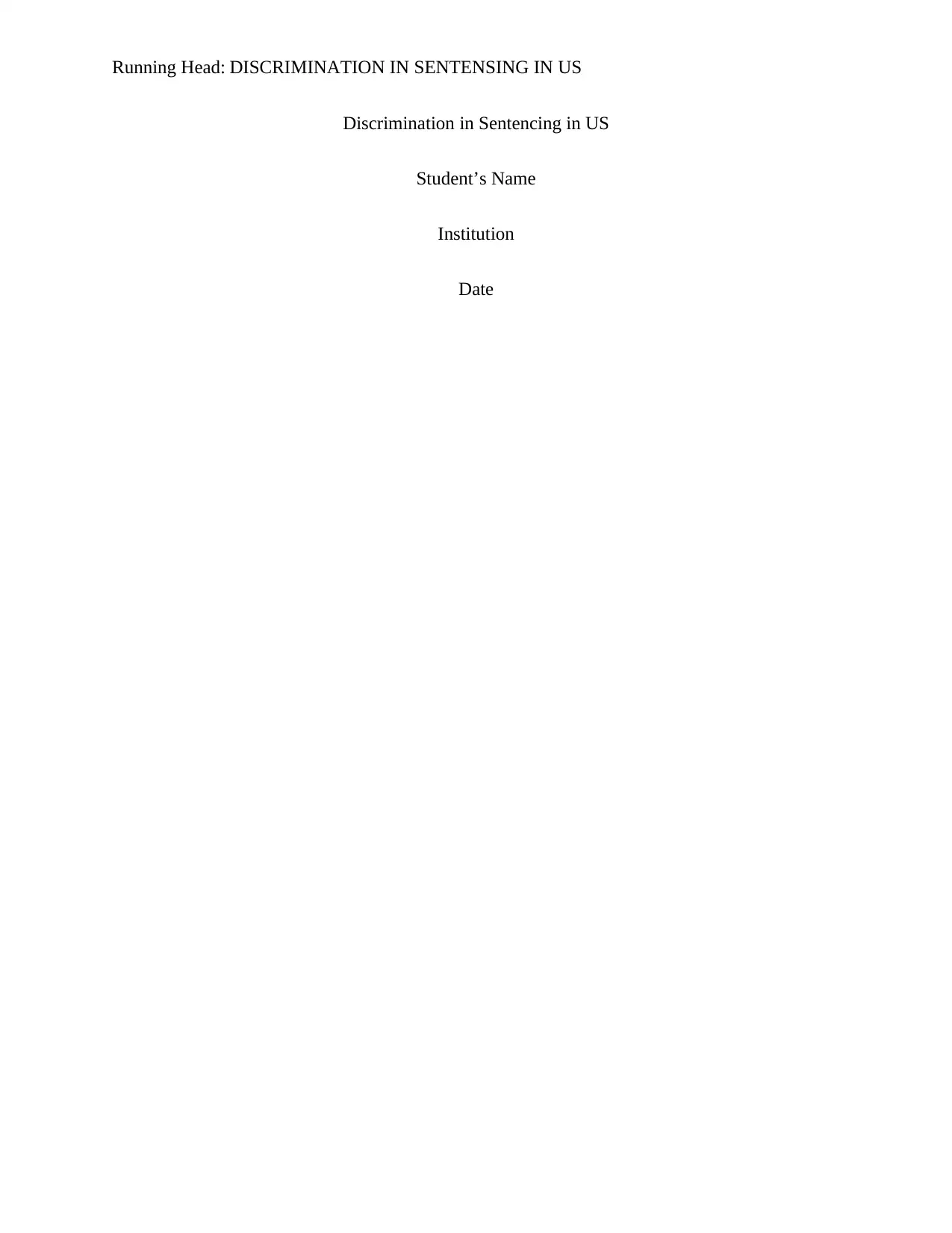
Running Head: DISCRIMINATION IN SENTENSING IN US
Discrimination in Sentencing in US
Student’s Name
Institution
Date
Discrimination in Sentencing in US
Student’s Name
Institution
Date
Paraphrase This Document
Need a fresh take? Get an instant paraphrase of this document with our AI Paraphraser
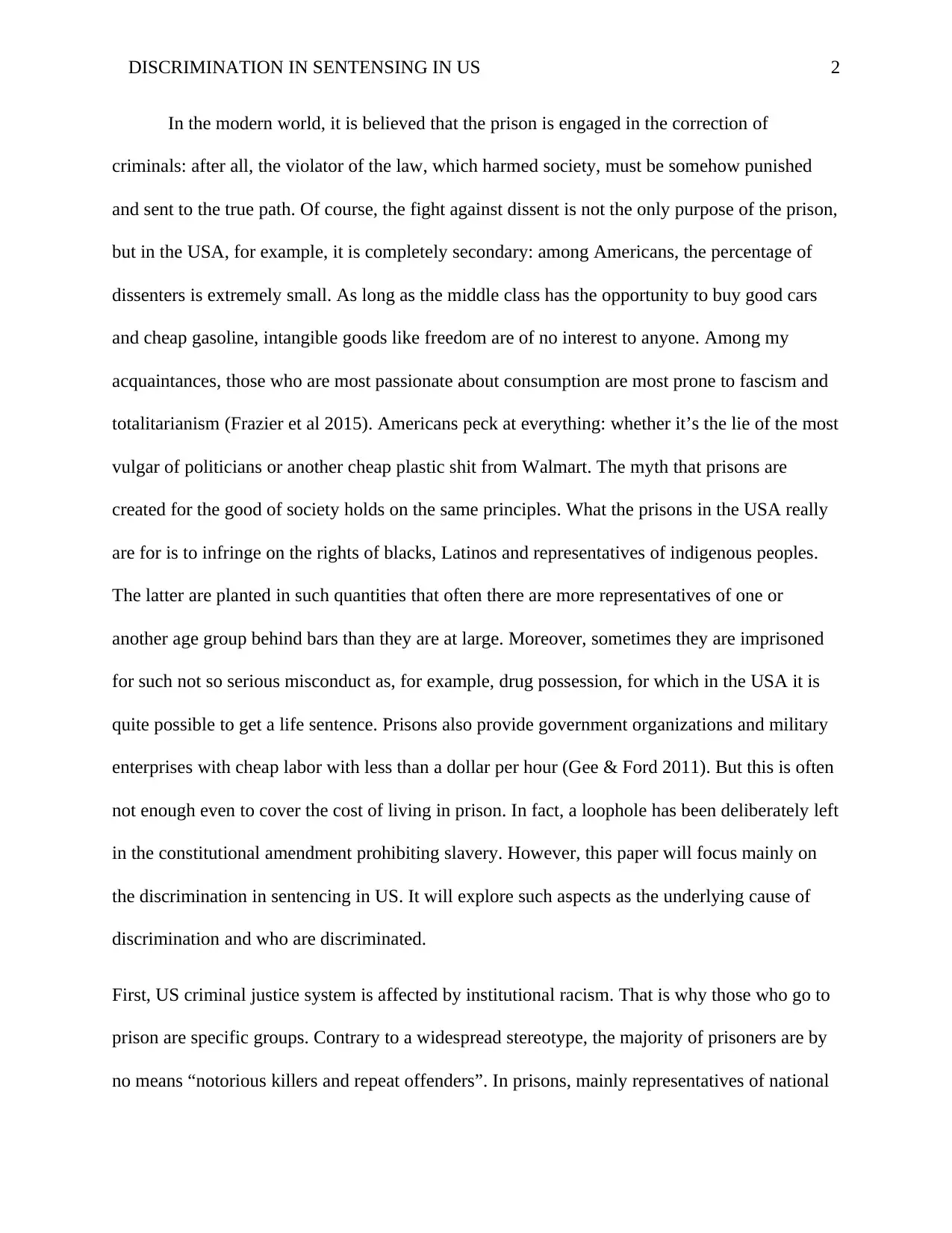
DISCRIMINATION IN SENTENSING IN US 2
In the modern world, it is believed that the prison is engaged in the correction of
criminals: after all, the violator of the law, which harmed society, must be somehow punished
and sent to the true path. Of course, the fight against dissent is not the only purpose of the prison,
but in the USA, for example, it is completely secondary: among Americans, the percentage of
dissenters is extremely small. As long as the middle class has the opportunity to buy good cars
and cheap gasoline, intangible goods like freedom are of no interest to anyone. Among my
acquaintances, those who are most passionate about consumption are most prone to fascism and
totalitarianism (Frazier et al 2015). Americans peck at everything: whether it’s the lie of the most
vulgar of politicians or another cheap plastic shit from Walmart. The myth that prisons are
created for the good of society holds on the same principles. What the prisons in the USA really
are for is to infringe on the rights of blacks, Latinos and representatives of indigenous peoples.
The latter are planted in such quantities that often there are more representatives of one or
another age group behind bars than they are at large. Moreover, sometimes they are imprisoned
for such not so serious misconduct as, for example, drug possession, for which in the USA it is
quite possible to get a life sentence. Prisons also provide government organizations and military
enterprises with cheap labor with less than a dollar per hour (Gee & Ford 2011). But this is often
not enough even to cover the cost of living in prison. In fact, a loophole has been deliberately left
in the constitutional amendment prohibiting slavery. However, this paper will focus mainly on
the discrimination in sentencing in US. It will explore such aspects as the underlying cause of
discrimination and who are discriminated.
First, US criminal justice system is affected by institutional racism. That is why those who go to
prison are specific groups. Contrary to a widespread stereotype, the majority of prisoners are by
no means “notorious killers and repeat offenders”. In prisons, mainly representatives of national
In the modern world, it is believed that the prison is engaged in the correction of
criminals: after all, the violator of the law, which harmed society, must be somehow punished
and sent to the true path. Of course, the fight against dissent is not the only purpose of the prison,
but in the USA, for example, it is completely secondary: among Americans, the percentage of
dissenters is extremely small. As long as the middle class has the opportunity to buy good cars
and cheap gasoline, intangible goods like freedom are of no interest to anyone. Among my
acquaintances, those who are most passionate about consumption are most prone to fascism and
totalitarianism (Frazier et al 2015). Americans peck at everything: whether it’s the lie of the most
vulgar of politicians or another cheap plastic shit from Walmart. The myth that prisons are
created for the good of society holds on the same principles. What the prisons in the USA really
are for is to infringe on the rights of blacks, Latinos and representatives of indigenous peoples.
The latter are planted in such quantities that often there are more representatives of one or
another age group behind bars than they are at large. Moreover, sometimes they are imprisoned
for such not so serious misconduct as, for example, drug possession, for which in the USA it is
quite possible to get a life sentence. Prisons also provide government organizations and military
enterprises with cheap labor with less than a dollar per hour (Gee & Ford 2011). But this is often
not enough even to cover the cost of living in prison. In fact, a loophole has been deliberately left
in the constitutional amendment prohibiting slavery. However, this paper will focus mainly on
the discrimination in sentencing in US. It will explore such aspects as the underlying cause of
discrimination and who are discriminated.
First, US criminal justice system is affected by institutional racism. That is why those who go to
prison are specific groups. Contrary to a widespread stereotype, the majority of prisoners are by
no means “notorious killers and repeat offenders”. In prisons, mainly representatives of national
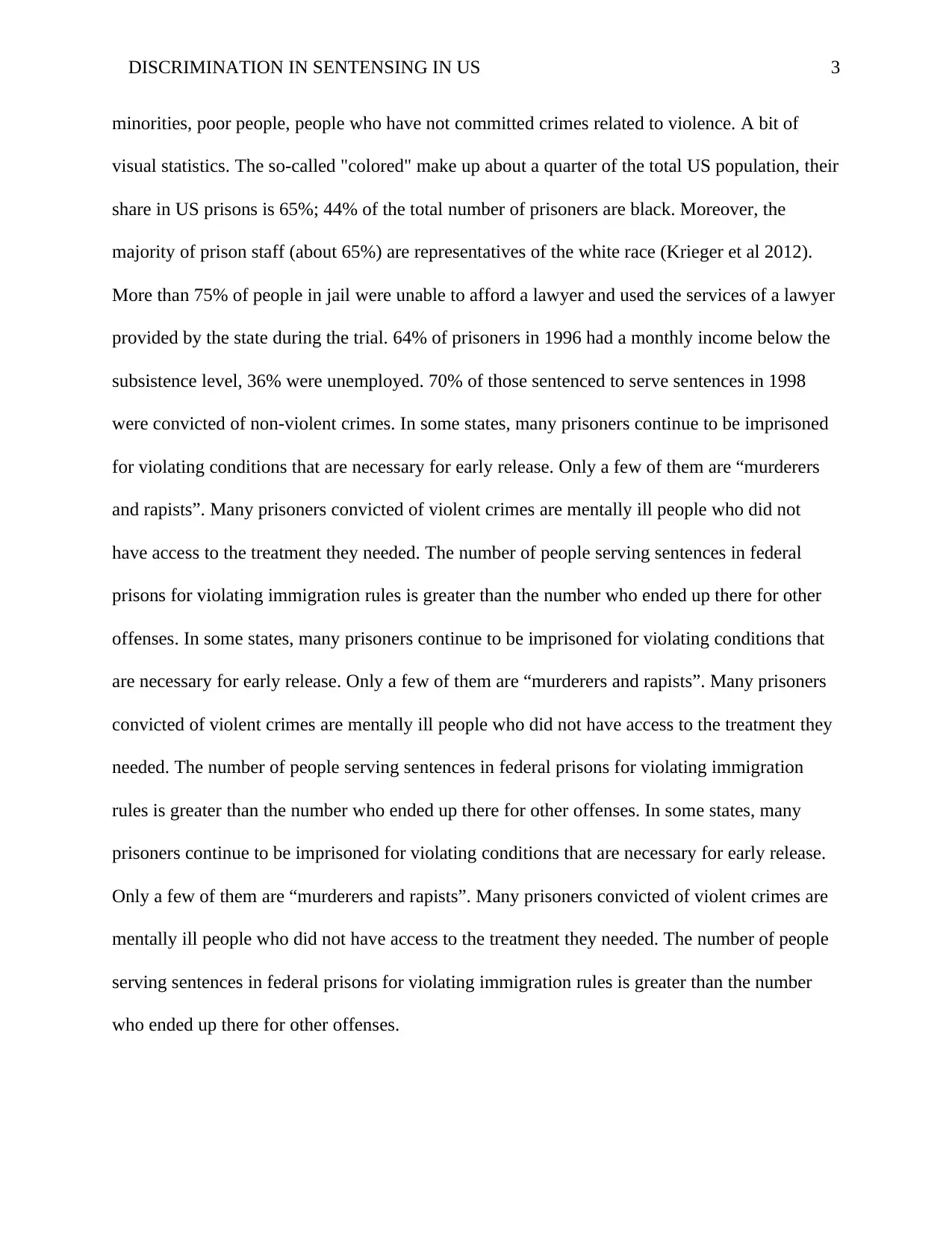
DISCRIMINATION IN SENTENSING IN US 3
minorities, poor people, people who have not committed crimes related to violence. A bit of
visual statistics. The so-called "colored" make up about a quarter of the total US population, their
share in US prisons is 65%; 44% of the total number of prisoners are black. Moreover, the
majority of prison staff (about 65%) are representatives of the white race (Krieger et al 2012).
More than 75% of people in jail were unable to afford a lawyer and used the services of a lawyer
provided by the state during the trial. 64% of prisoners in 1996 had a monthly income below the
subsistence level, 36% were unemployed. 70% of those sentenced to serve sentences in 1998
were convicted of non-violent crimes. In some states, many prisoners continue to be imprisoned
for violating conditions that are necessary for early release. Only a few of them are “murderers
and rapists”. Many prisoners convicted of violent crimes are mentally ill people who did not
have access to the treatment they needed. The number of people serving sentences in federal
prisons for violating immigration rules is greater than the number who ended up there for other
offenses. In some states, many prisoners continue to be imprisoned for violating conditions that
are necessary for early release. Only a few of them are “murderers and rapists”. Many prisoners
convicted of violent crimes are mentally ill people who did not have access to the treatment they
needed. The number of people serving sentences in federal prisons for violating immigration
rules is greater than the number who ended up there for other offenses. In some states, many
prisoners continue to be imprisoned for violating conditions that are necessary for early release.
Only a few of them are “murderers and rapists”. Many prisoners convicted of violent crimes are
mentally ill people who did not have access to the treatment they needed. The number of people
serving sentences in federal prisons for violating immigration rules is greater than the number
who ended up there for other offenses.
minorities, poor people, people who have not committed crimes related to violence. A bit of
visual statistics. The so-called "colored" make up about a quarter of the total US population, their
share in US prisons is 65%; 44% of the total number of prisoners are black. Moreover, the
majority of prison staff (about 65%) are representatives of the white race (Krieger et al 2012).
More than 75% of people in jail were unable to afford a lawyer and used the services of a lawyer
provided by the state during the trial. 64% of prisoners in 1996 had a monthly income below the
subsistence level, 36% were unemployed. 70% of those sentenced to serve sentences in 1998
were convicted of non-violent crimes. In some states, many prisoners continue to be imprisoned
for violating conditions that are necessary for early release. Only a few of them are “murderers
and rapists”. Many prisoners convicted of violent crimes are mentally ill people who did not
have access to the treatment they needed. The number of people serving sentences in federal
prisons for violating immigration rules is greater than the number who ended up there for other
offenses. In some states, many prisoners continue to be imprisoned for violating conditions that
are necessary for early release. Only a few of them are “murderers and rapists”. Many prisoners
convicted of violent crimes are mentally ill people who did not have access to the treatment they
needed. The number of people serving sentences in federal prisons for violating immigration
rules is greater than the number who ended up there for other offenses. In some states, many
prisoners continue to be imprisoned for violating conditions that are necessary for early release.
Only a few of them are “murderers and rapists”. Many prisoners convicted of violent crimes are
mentally ill people who did not have access to the treatment they needed. The number of people
serving sentences in federal prisons for violating immigration rules is greater than the number
who ended up there for other offenses.
⊘ This is a preview!⊘
Do you want full access?
Subscribe today to unlock all pages.

Trusted by 1+ million students worldwide
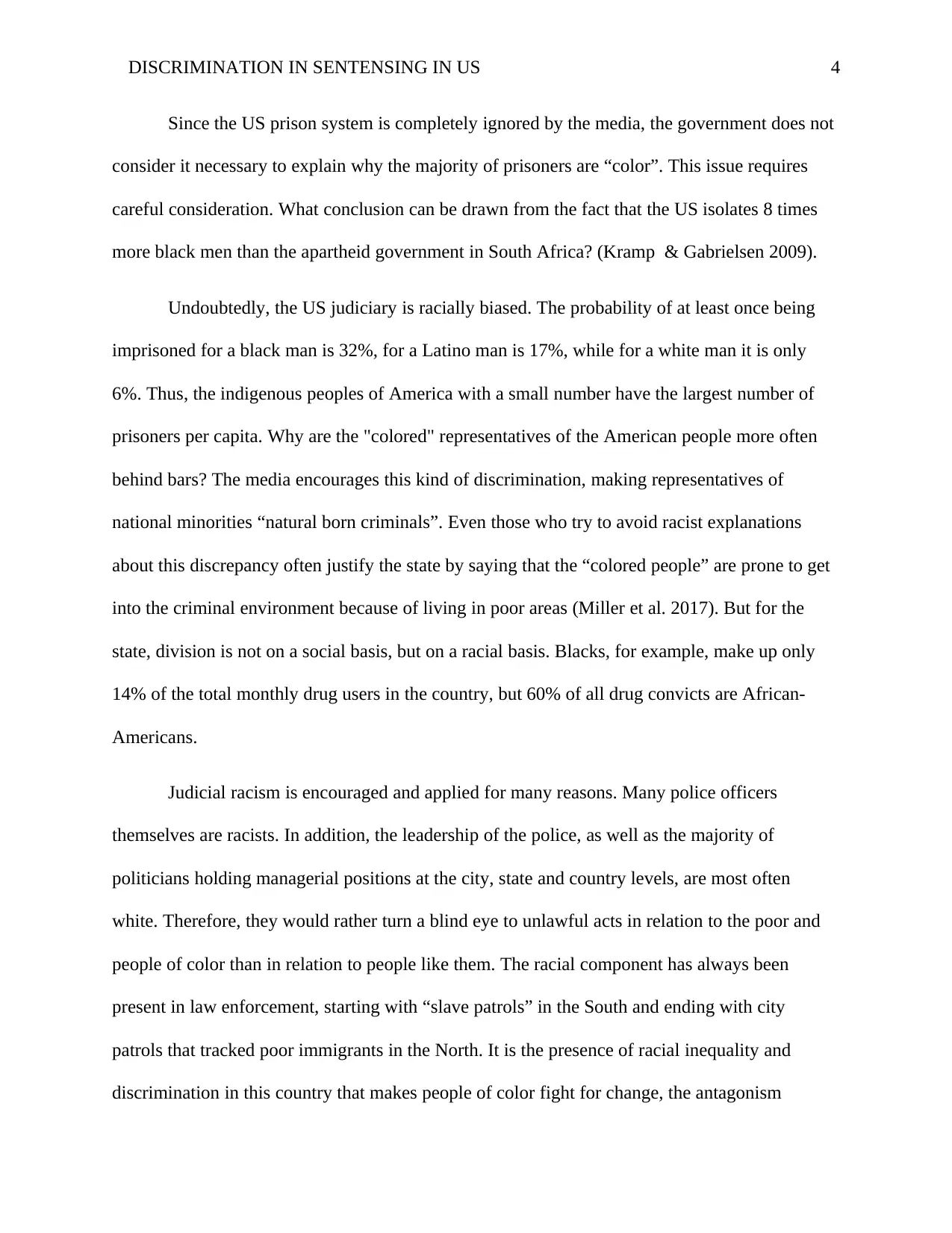
DISCRIMINATION IN SENTENSING IN US 4
Since the US prison system is completely ignored by the media, the government does not
consider it necessary to explain why the majority of prisoners are “color”. This issue requires
careful consideration. What conclusion can be drawn from the fact that the US isolates 8 times
more black men than the apartheid government in South Africa? (Kramp & Gabrielsen 2009).
Undoubtedly, the US judiciary is racially biased. The probability of at least once being
imprisoned for a black man is 32%, for a Latino man is 17%, while for a white man it is only
6%. Thus, the indigenous peoples of America with a small number have the largest number of
prisoners per capita. Why are the "colored" representatives of the American people more often
behind bars? The media encourages this kind of discrimination, making representatives of
national minorities “natural born criminals”. Even those who try to avoid racist explanations
about this discrepancy often justify the state by saying that the “colored people” are prone to get
into the criminal environment because of living in poor areas (Miller et al. 2017). But for the
state, division is not on a social basis, but on a racial basis. Blacks, for example, make up only
14% of the total monthly drug users in the country, but 60% of all drug convicts are African-
Americans.
Judicial racism is encouraged and applied for many reasons. Many police officers
themselves are racists. In addition, the leadership of the police, as well as the majority of
politicians holding managerial positions at the city, state and country levels, are most often
white. Therefore, they would rather turn a blind eye to unlawful acts in relation to the poor and
people of color than in relation to people like them. The racial component has always been
present in law enforcement, starting with “slave patrols” in the South and ending with city
patrols that tracked poor immigrants in the North. It is the presence of racial inequality and
discrimination in this country that makes people of color fight for change, the antagonism
Since the US prison system is completely ignored by the media, the government does not
consider it necessary to explain why the majority of prisoners are “color”. This issue requires
careful consideration. What conclusion can be drawn from the fact that the US isolates 8 times
more black men than the apartheid government in South Africa? (Kramp & Gabrielsen 2009).
Undoubtedly, the US judiciary is racially biased. The probability of at least once being
imprisoned for a black man is 32%, for a Latino man is 17%, while for a white man it is only
6%. Thus, the indigenous peoples of America with a small number have the largest number of
prisoners per capita. Why are the "colored" representatives of the American people more often
behind bars? The media encourages this kind of discrimination, making representatives of
national minorities “natural born criminals”. Even those who try to avoid racist explanations
about this discrepancy often justify the state by saying that the “colored people” are prone to get
into the criminal environment because of living in poor areas (Miller et al. 2017). But for the
state, division is not on a social basis, but on a racial basis. Blacks, for example, make up only
14% of the total monthly drug users in the country, but 60% of all drug convicts are African-
Americans.
Judicial racism is encouraged and applied for many reasons. Many police officers
themselves are racists. In addition, the leadership of the police, as well as the majority of
politicians holding managerial positions at the city, state and country levels, are most often
white. Therefore, they would rather turn a blind eye to unlawful acts in relation to the poor and
people of color than in relation to people like them. The racial component has always been
present in law enforcement, starting with “slave patrols” in the South and ending with city
patrols that tracked poor immigrants in the North. It is the presence of racial inequality and
discrimination in this country that makes people of color fight for change, the antagonism
Paraphrase This Document
Need a fresh take? Get an instant paraphrase of this document with our AI Paraphraser
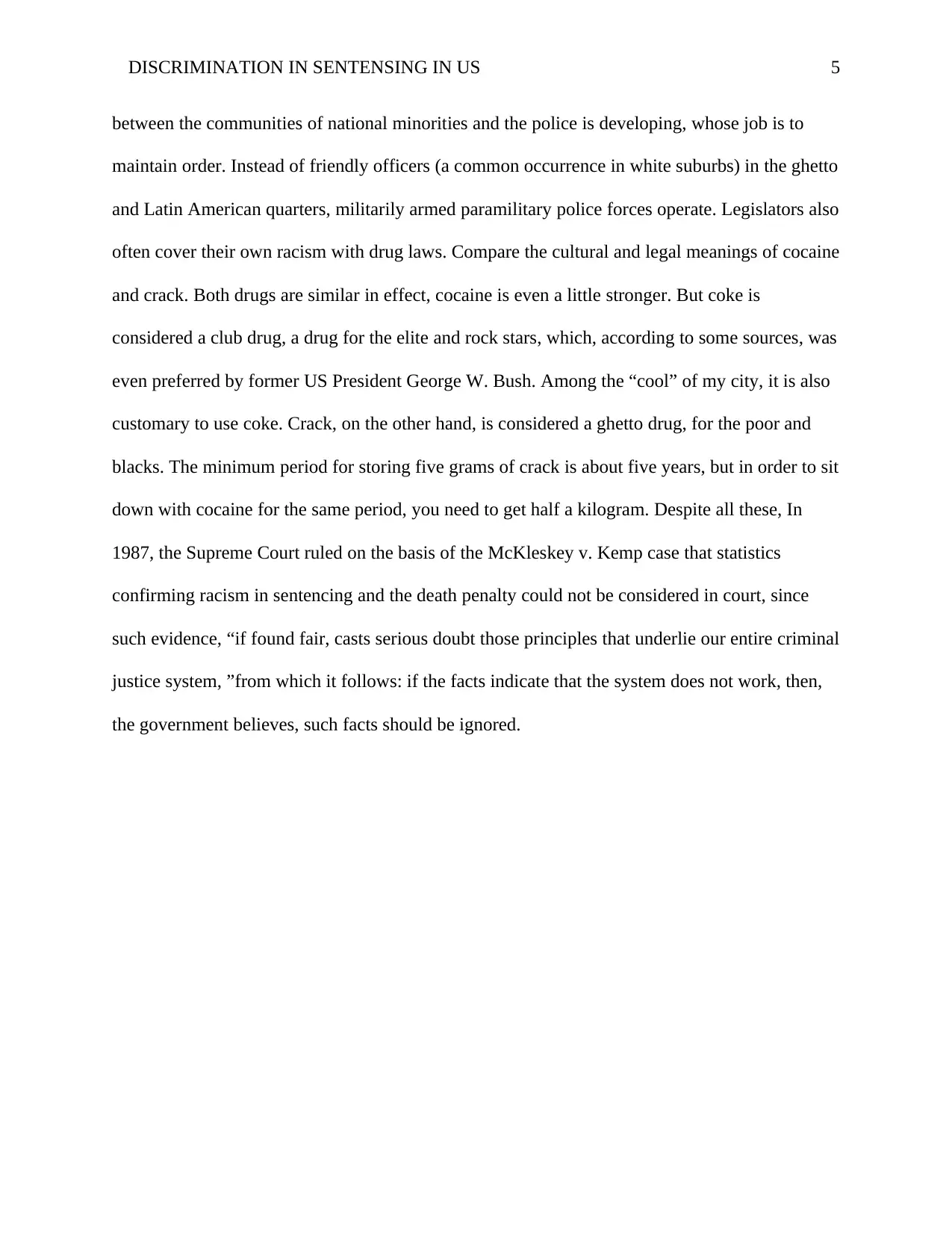
DISCRIMINATION IN SENTENSING IN US 5
between the communities of national minorities and the police is developing, whose job is to
maintain order. Instead of friendly officers (a common occurrence in white suburbs) in the ghetto
and Latin American quarters, militarily armed paramilitary police forces operate. Legislators also
often cover their own racism with drug laws. Compare the cultural and legal meanings of cocaine
and crack. Both drugs are similar in effect, cocaine is even a little stronger. But coke is
considered a club drug, a drug for the elite and rock stars, which, according to some sources, was
even preferred by former US President George W. Bush. Among the “cool” of my city, it is also
customary to use coke. Crack, on the other hand, is considered a ghetto drug, for the poor and
blacks. The minimum period for storing five grams of crack is about five years, but in order to sit
down with cocaine for the same period, you need to get half a kilogram. Despite all these, In
1987, the Supreme Court ruled on the basis of the McKleskey v. Kemp case that statistics
confirming racism in sentencing and the death penalty could not be considered in court, since
such evidence, “if found fair, casts serious doubt those principles that underlie our entire criminal
justice system, ”from which it follows: if the facts indicate that the system does not work, then,
the government believes, such facts should be ignored.
between the communities of national minorities and the police is developing, whose job is to
maintain order. Instead of friendly officers (a common occurrence in white suburbs) in the ghetto
and Latin American quarters, militarily armed paramilitary police forces operate. Legislators also
often cover their own racism with drug laws. Compare the cultural and legal meanings of cocaine
and crack. Both drugs are similar in effect, cocaine is even a little stronger. But coke is
considered a club drug, a drug for the elite and rock stars, which, according to some sources, was
even preferred by former US President George W. Bush. Among the “cool” of my city, it is also
customary to use coke. Crack, on the other hand, is considered a ghetto drug, for the poor and
blacks. The minimum period for storing five grams of crack is about five years, but in order to sit
down with cocaine for the same period, you need to get half a kilogram. Despite all these, In
1987, the Supreme Court ruled on the basis of the McKleskey v. Kemp case that statistics
confirming racism in sentencing and the death penalty could not be considered in court, since
such evidence, “if found fair, casts serious doubt those principles that underlie our entire criminal
justice system, ”from which it follows: if the facts indicate that the system does not work, then,
the government believes, such facts should be ignored.
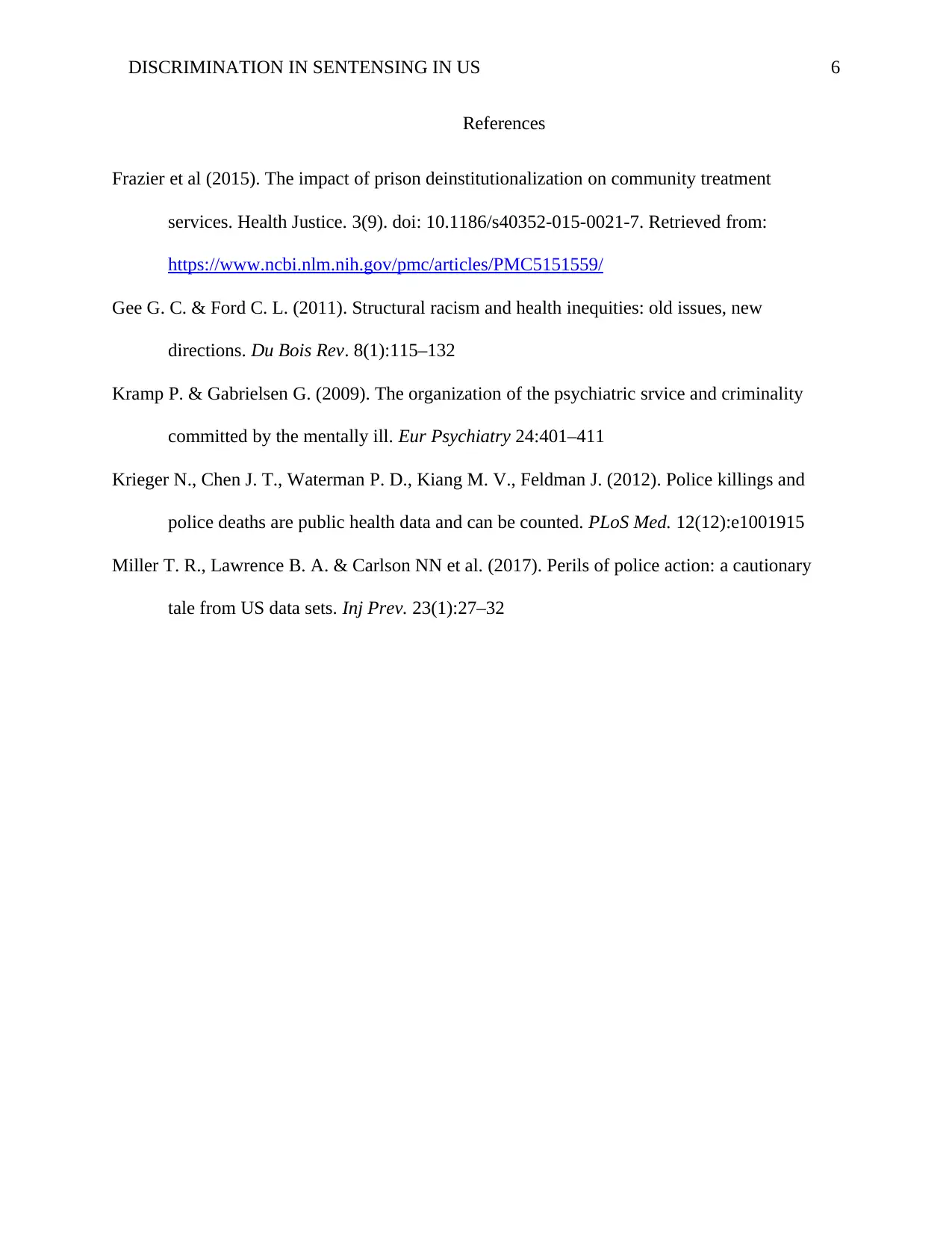
DISCRIMINATION IN SENTENSING IN US 6
References
Frazier et al (2015). The impact of prison deinstitutionalization on community treatment
services. Health Justice. 3(9). doi: 10.1186/s40352-015-0021-7. Retrieved from:
https://www.ncbi.nlm.nih.gov/pmc/articles/PMC5151559/
Gee G. C. & Ford C. L. (2011). Structural racism and health inequities: old issues, new
directions. Du Bois Rev. 8(1):115–132
Kramp P. & Gabrielsen G. (2009). The organization of the psychiatric srvice and criminality
committed by the mentally ill. Eur Psychiatry 24:401–411
Krieger N., Chen J. T., Waterman P. D., Kiang M. V., Feldman J. (2012). Police killings and
police deaths are public health data and can be counted. PLoS Med. 12(12):e1001915
Miller T. R., Lawrence B. A. & Carlson NN et al. (2017). Perils of police action: a cautionary
tale from US data sets. Inj Prev. 23(1):27–32
References
Frazier et al (2015). The impact of prison deinstitutionalization on community treatment
services. Health Justice. 3(9). doi: 10.1186/s40352-015-0021-7. Retrieved from:
https://www.ncbi.nlm.nih.gov/pmc/articles/PMC5151559/
Gee G. C. & Ford C. L. (2011). Structural racism and health inequities: old issues, new
directions. Du Bois Rev. 8(1):115–132
Kramp P. & Gabrielsen G. (2009). The organization of the psychiatric srvice and criminality
committed by the mentally ill. Eur Psychiatry 24:401–411
Krieger N., Chen J. T., Waterman P. D., Kiang M. V., Feldman J. (2012). Police killings and
police deaths are public health data and can be counted. PLoS Med. 12(12):e1001915
Miller T. R., Lawrence B. A. & Carlson NN et al. (2017). Perils of police action: a cautionary
tale from US data sets. Inj Prev. 23(1):27–32
⊘ This is a preview!⊘
Do you want full access?
Subscribe today to unlock all pages.

Trusted by 1+ million students worldwide
1 out of 6
Related Documents
Your All-in-One AI-Powered Toolkit for Academic Success.
+13062052269
info@desklib.com
Available 24*7 on WhatsApp / Email
![[object Object]](/_next/static/media/star-bottom.7253800d.svg)
Unlock your academic potential
Copyright © 2020–2025 A2Z Services. All Rights Reserved. Developed and managed by ZUCOL.




